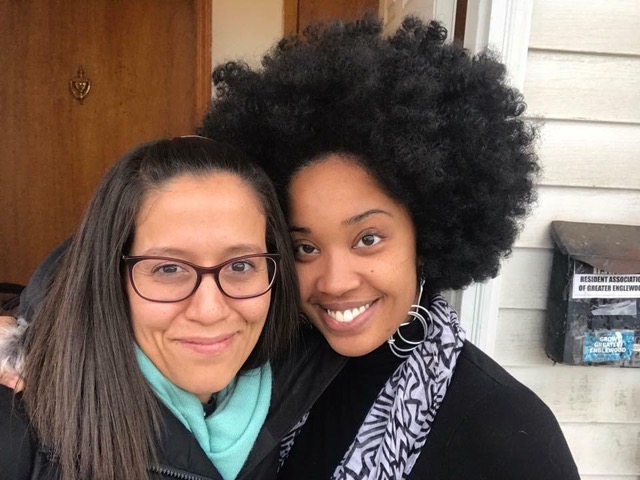
Tonika Lewis Johnson and Paola Aguirre Serrano
Tonika Lewis Johnson and Paola Aguirre Serrano are Chicagoans whose imaginative work with maps invites people into new relationships with their city. NACIS is pleased to announce them as the recipients of the 2020–2021 Corlis Benefideo Award.
Ms. Lewis Johnson is a photographer/visual artist and lifelong resident of Chicago’s South Side neighborhood of Englewood. She learned to navigate Chicago’s grid while riding the CTA to high school, observing differences in investment, building conditions, and public facilities as she traveled from south to north. Her Folded Map project employs the abstract nature of maps to get at the physicality of the experience of living in a segregated city. Pairing “map twins” from addresses north and south of a zero coordinate, the Folded Map uses the grid to reflect the city back on itself and create personal encounters that defy Chicago’s long and enduring history of segregation. These new pairings create space for Chicagoans to meet each other, explore differences, and question assumptions. Lewis Johnson has transformed this project into an advocacy and policy-influencing tool. In 2019, she was named one of Field Foundation’s Leaders for a New Chicago and, most recently, she was appointed as a member of the Cultural Advisory Council of the Department of Cultural Affairs and Special Events by the Chicago City Council. She is a cofounder of Resident Association of Greater Englewood (R.A.G.E.) and continues to photo-document the beauty and rituals of everyday life in Englewood.
Paola Aguirre Serrano is the founder of Borderless, an urban design and research practice based in Chicago. Trained as an architect and urban designer, her professional experience includes working with government, universities and architecture/urban design offices both in Mexico and the United States. In collaboration with Lewis Johnson, Aguirre Serrano designed an interactive map installation to visualize the geographic nature of the Folded Map. Oriented with Lake Michigan (east) at the bottom, the South Side of the city becomes the first stop for gallery guests, who are invited to use pegs and strings to find themselves and their “map twins” on the wall, and to note infrastructure differences in reflected neighborhoods. Aguirre Serrano’s interest is “using maps as a tool to make visible things that … are not part of the streamlined narratives”. She has created mapping workshops to understand urban challenges along the US-Mexico border. Her initiative Creative Grounds uses giant maps painted in playgrounds as a way of exploring the role of school grounds after the largest public schools closure in Chicago history.
Lewis Johnson’s and Aguirre Serrano’s work is precisely the kind of thing that NACIS had in mind when we formulated the award, which celebrates those who “take our established traditions of mapmaking, and indeed take fully-constructed maps themselves, and turn them on their heads to make us see ourselves anew.” We are grateful for this fresh perspective and hope it infuses our work and creates new connections. We want to make it easier for map-makers and prospective map-makers in a variety of disciplines to have the conversations we need to have to make better maps. It is about stretching cartography, without breaking it. We need to keep remaking cartography anew, and this award points to people whose work forces us to see maps and the world they describe in new and surprising ways.
The Corlis Benefideo Award is named after the master mapmaker who is the subject of Barry Lopez’s short story “The Mappist,” which is collected in Light Action in the Caribbean. The name is used with the permission of Mr. Lopez, with our grateful thanks.
